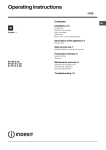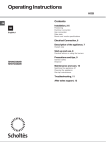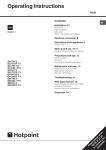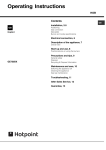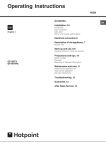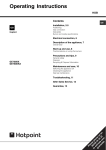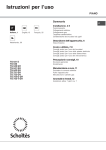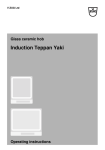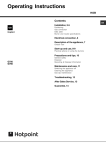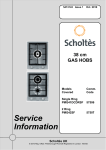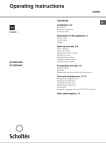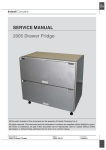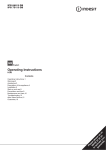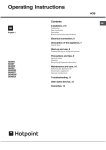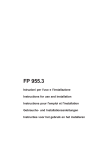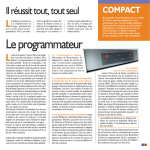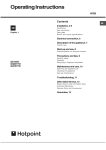Download Operating Instructions
Transcript
Operating Instructions HOB GB GB English,1 Contents Installation, 2-7 Positioning Electrical connection Gas connection Data plate Burner and nozzle specifications Description of the appliance, 8 Overall view Start-up and use, 9-10 Practical advice on using the burners Precautions and tips, 11 SH09PGWAX General safety Disposal Maintenance and care, 12 Switching the appliance off Cleaning the appliance Gas tap maintenance Troubleshooting, 13 After sales support, 14 Installation ! Please keep these operating instructions for future reference. Pass them on to possible new owners of the appliance. ! Intensive and prolonged use may require additional ventilation, for example, opening a window or ventilation more efficient by increasing the suction power The appliance has the following technical specifications: Category: II 2H3+ Positioning ! Keep packaging material out of the reach of children. It can become a choking or suffocation hazard (see Precautions and tips). ! The appliance must be installed by a qualified professional according to the instructions provided. Incorrect installation may cause harm to people and animals or may damage property. ! This unit may be installed and used only in permanently ventilated rooms in accordance with British Standard Codes Of Practice: B.S. 6172 / B.S. 5440, Par. 2 and B.S. 6891 Current Editions. The following requirements must be observed: • The room must be equipped with an air extraction system that expels any combustion fumes. This may consist of a hood or an electric fan that automatically starts each time the appliance is switched on. The system can also provide the air needed for combustion indirectly, i.e. from adjacent rooms fitted with air circulation tubes as described above. However, these rooms must not Enlarging the ventilation slot be communal rooms, bedrooms between window and floor. or rooms that may present a fire hazard. • Liquid petroleum gas sinks to the floor as it is heavier than air. Therefore, rooms containing LPG cylinders must also be equipped with vents to allow gas to escape in the event of a leak. As a result LPG cylinders, whether partially or completely full, must not be installed or stored in rooms or storage areas that are below ground level (cellars, etc.). It is advisable to keep only the cylinder being used in the room, positioned so that it is not subject to heat produced by external sources (ovens, fireplaces, stoves, etc. ) which could raise the temperature of the cylinder above 50°C. Adjacent Room In a chimney stack or branched flue. (exclusively for cooking appliances) Fitting the appliance Gas and mixed hobs are manufactured with type X degree protection against overheating. The following precautions must be taken when installing the hob: • Kitchen cabinets adjacent to the appliance and taller than the top of the hob must be at least 50 mm from the edge of the hob. • Hoods must be installed according to their relative installation instruction manuals and at a minimum distance of 700 mm from the hob. 600mm min. Directly to the Outside • The room must also allow proper air circulation, as air is needed for combustion to occur normally. The flow of air must not be less than 2 m3/h per kW of installed power. The air circulation system may take air directly from the outside by means of a pipe with an inner cross section of at least 100 A cm2; the opening must not be Examples of ventilation holes vulnerable to any type of for comburant air. blockages. 2 Room to be Vented 540mm min. ! Before operating your new appliance please read this instruction booklet carefully. It contains important information for safe use, installation and care of the appliance. 700mm min. GB • Place the wall cabinets adjacent to the hood at a minimum height of 540 mm from the hob (see figure). If the hob is installed beneath a wall cabinet, the latter must be situated at a minimum of 700 mm above the hob (see figure). Installation Make sure you take all the necessary precautions to guarantee proper installation in compliance with the applicable norms in force regarding accident-prevention for electrical connection. For the correct operation of the appliance when built into the cabinet, it is vital that the minimum distances illustrated in Fig. 1 be respected. The hob features a type Y degree of protection against overheating in compliance with norms. All surfaces adjacent to the cabinet and the back panel should be made of materials resistant to a temperature of 65°C. m Min. M in.700mm 700m m 50 m mm 50 2- Built-in hobs (Class 3) with edges lower than 58 mm (see figure 2, detail H2). To install this type of hob, a hole large enough to accommodate the whole lower casing of the appliance must be made on the worktop intended to be under the hob. Remember to leave a gap of at least 1 cm between the lower casing and the worktop around the whole perimeter of the appliance (the underside of the casing can, however, touch the surface below it). To fit the appliances, follow the instructions given above in point 1 or use any supplementary instruction leaflet that is provided in special cases. Fig.1 Securing the appliance to the cabinet There are three different groups of appliance as far as installation is concerned: BUILT-IN HOB HEIGHT= STEEL THICKNESS BUILT-IN HOB STEEL TICKNESS <HEIGHT <58mm SIT ON - ON HOB HEIGHT >58mm Fig.3 FOR MOD: SH09PGWAX Fig.2 51 1- Built-in hobs to be slotted in (Class 3 - see figure 2, detail H1). In this case it is necessary to make a hole in the worktop whose measurements match those of the hob. The measurement at the side should be reduced by 1 cm so as to ensure that 1 cm of the perimeter of the hob overlaps with and rests on top of the supporting surface. To slot in the hob flush with the worktop, the cut-out on this supporting surface must be lowered (see figure 4a), so that both the edge of the hob and the seal under it can be positioned there. Before fitting the hob to the worktop, position the seal provided along the perimeter of the hob. Brackets for fixing hobs to the cabinet have been provided, and these should be fitted as shown in detail S (fig.3). 0 86 49 5 0 84 5 Fig.4a 3 GB GB 3- Sit-on hobs (Class 1) with edges higher than 58 mm (see figure 2, detail H3). In this case, the lower casing of the hob does not protrude further than the edge of the appliance. Even when the hob is resting on the worktop, it will suffice to leave space for the gas supply tube and electricity supply cable. To fit this type of hob, follow the instructions below (fig. 5): • Fix the two screws provided "A" at a distance from the back panel as shown in figure 5, leaving the heads of the screws sticking out of the wood by 1.5 mm. • Hook the hob onto the two screws "A" and push it towards the back. • Fix the appliance to the cabinet at the rear, using the two brackets "B" and the four screws "C" (these are all provided). X mm Fig.5 X mm N.B.: to make maintenance operations more efficient, the area around the hob must be easily accessible after it has been installed (i.e. there are no completely shutoff elements). N.B.: An insulating wooden panel should be fitted beneath the hob, positioned at a minimum of 20 mm from the hob underside. This wooden panel must be removable in order to allow for any maintenance operations beneath the hob. 4 Electrical connection Gas connection Hobs equipped with a three-pole power supply cable are designed to operate with alternating current at the voltage and frequency indicated on the data plate (this is located on the lower part of the appliance). The earth wire in the cable has a green and yellow cover. If the appliance is to be installed above a built-in electric oven, the electrical connection of the hob and the oven must be carried out separately, both for electrical safety purposes and to make extracting the oven easier. This appliance is designated and set to work with the gas indicated on the label situated on the type for which the appliance has been set, proceed with replacing the corresponding nozzles (provided), following instruction given in the paragraph "adaptation to different types ok gas". Connecting the supply cable to the mains Install a standardised plug corresponding to the load indicated on the data plate. The appliance must be directly connected to the mains using an omnipolar circuit-breaker with a minimum contact opening of 3 mm installed between the appliance and the mains. The circuit-breaker must be suitable for the charge indicated and must comply with current electrical regulations (the earthing wire must not be interrupted by the circuitbreaker). The supply cable must not come into contact with surfaces with temperatures higher than 50°C. ! The installer must ensure that the correct electrical connection has been made and that it is compliant with safety regulations. Before connecting to the power supply, make sure that: • The appliance is earthed and the plug is compliant with the law. • The socket can withstand the maximum power of the appliance, which is indicated on the data plate. • The voltage is in the range between the values indicated on the data plate. • The socket is compatible with the plug of the appliance. If the socket is incompatible with the plug, ask an authorised technician to replace it. Do not use extension cords or multiple sockets. ! Once the appliance has been installed, the power supply cable and the electrical socket must be easily accessible. ! The cable must not be bent or compressed. ! The cable must be checked regularly and replaced by authorised technicians only (Should assistance be required, please telephone Scholtès Assistance free number 0800 158 55 00). ! The manufacturer declines any liability should these safety measures not be observed. GB The appliance should be connected to the main gas supply or to a gas cylinder in compliance with current national regulations. Before carrying out the connection, make sure the cooker is compatible with the gas supply you wish to use. If this is not the case, follow the instructions indicated in the paragraph “Adapting to different types of gas.” When using liquid gas from a cylinder, install a pressure regulator which complies with current national regulations. ! Check that the pressure of the gas supply is consistent with the values indicated in Table 1 (“Burner and nozzle specifications”). This will ensure the safe operation and longevity of your appliance while maintaining efficient energy consumption. Connection with a rigid pipe (copper or steel) ! Connection to the gas system must be carried out in such a way as not to place any strain of any kind on the appliance. There is an adjustable L-shaped pipe fitting on the appliance supply ramp and this is fitted with a seal in order to prevent leaks. The seal must always be replaced after rotating the pipe fitting (seal provided with appliance). The gas supply pipe fitting is a threaded 1/2 gas cylindrical male attachment. Connecting a flexible jointless stainless steel pipe to a threaded attachment The gas supply pipe fitting is a threaded 1/2 gas cylindrical male attachment. These pipes must be installed so that they are never longer than 2000 mm when fully extended. Once connection has been carried out, make sure that the flexible metal pipe does not touch any moving parts and is not compressed. ! Only use pipes and seals that comply with current national regulations. Checking the tightness of the connection ! When the installation process is complete, check the pipe fittings for leaks using a soapy solution. Never use a flame. 5 GB Adapting to different types of gas To adapt the hob to a different type of gas other than default type (indicated on the rating plate at the base of the hob or on the packaging), the burner nozzles should be replaced as follows: 1. Remove the hob grids and slide the burners off their seats. 2. Unscrew the nozzles using a 7 mm socket spanner, and replace them with nozzles for the new type of gas (see table 1 “Burner and nozzle characteristics”). 3. Reassemble the parts following the above procedure in the reverse order. 5. Once the adjustment has been made, replace the seals on the by-passes using sealing wax or a similar substance. ! If the appliance is connected to liquid gas, the regulation screw must be fastened as tightly as possible. ! Once this procedure is finished, replace the old rating sticker with one indicating the new type of gas used. Stickers are available from any of our Service Centres. ! Should the gas pressure used be different (or vary slightly) from the recommended pressure, a suitable pressure regulator must be fitted to the inlet pipe (in order to comply with current national regulations). 4. Once this procedure is finished, replace the old rating sticker with one indicating the new type of gas used. Sticker are available from any of our Service Centres. Replacing the nozzles on separate double crown wok burners: 1. remove the grids and slide the burners from their housings. The burner consists of 2 separate parts (see figure); 2. unscrew the burers with a 7 mm wrench spanner. The internal burner has a nozzle, the external burner has two (of the same size). Replace the nozzle with models suited to the new type of gas (see table 1). 3. replace all the components by repeating the steps in reverse order • Adjusting the burners’ primary air : Does not require adjusting. • Setting the burners to minimum: 1. Turn the tap to the low flame position. 2. Remove the knob and adjust the adjustment screw, which is positioned in or next to the tap pin, until the flame is small but steady. 3. Having adjusted the flame to the required low setting, while the burner is alight, quickly change the position of the knob from minimum to maximum and vice versa several times, checking that the flame does not go out. 4. Some appliances have a safety device (thermocouple) fitted. If the device fails to work when the burners are set to the low flame setting, increase this low flame setting using the adjusting screw. 6 DATA PLATE Electrical connections voltage of 220-240V ~ 50/60Hz (see data plate ) This appliance conforms to the following European Economic Community directives: -2006/95/EEC dated 12/12/06 (Low Voltage) and subsequent amendments - 2004/108/EEC dated 15/12/04 (Electromagnetic Compatibility) and subsequent amendments - 93/68/EEC dated 22/07/93 and subsequent amendments. - 2009/142/EEC dated 30/11/09 (Gas) and subsequent amendments. - 2002/96/EC and subsequent amendments. Burner and nozzle specifications Table 1 Liquid Gas Burner Diameter Thermal power (mm) kW (p.c.s.*) By-Pass 1/100 Nozzle 1/100 Flow* g/h Nozzle 1/100 Nomin. Ridot. (mm) (mm) *** ** (mm) Flow* l/h B. Semi fast 75 1,65 0,40 30 64 138 136 96 181 A. Auxiliary 55 1,00 0,40 30 50 73 71 71 95 C. Oval burner — 1,50 0,40 30 60 109 107 88 143 D. Double crown wok (inner DCDR) 30 0,90 0,40 30 44 65 64 70 86 D. Double crown wok (outer DCDR) 2 nozzle 130 4,10 1,30 57 70 298 293 110 390 28-30 20 35 37 25 45 Nominal (mbar) Minimum (mbar) Maximum (mbar) Supply Pressures * ** *** At 15°C and Propane Butane Natural GB Natural Gas 20 17 25 1013 mbar - dry gas P.C.S. = 50.37 MJ/Kg P.C.S. = 49.47 MJ/Kg P.C.S. = 37.78 MJ/m3 ! The hob can only be installed above built-in ovens with a cooling ventilation system. C B D C A 7 Description of the appliance GB Overall view Gas burners Pan supports Control knobs Flame supervision device • Gas burners differ in size and power as described in the previous page. Use the diameter of the cookware to choose the most appropriate burner to cook with. • Control knobs allow to adjust the power or the size of the flame. • The ignition enables a specific burner to be lit automatically when a knob is pushed down ad turned. • The flame supervision device is a safety device that automatically shuts off the supply of gas to the affected burner if the flame is extinguished for any reason, preventing potential gas leaks. 8 Ignition Start-up and use ! The position of the corresponding gas burner is shown on every knob. Gas burners Each burner can be adjusted to one of the following settings using the corresponding control knob: z Off Maximum Minimum To light each of the burners, press down the corresponding knob and turn it anti-clockwise to the maximum setting. Since each burner is fitted with a flame supervision device, the knob should be pressed and held for approximately 2-3 seconds to allow the automatic device keeping the flame alight to heat up. ! When there is no electricity supply, the burners can be lit with a match after turning the control knob to the flame position. To turn on one of the burners, place a lighted match or lighter near the burner, press the knob all the way in and turn it anti-clockwise to the "High" setting. To turn on one of the burners press the relevant knob all the way down and turn it anti-clockwise to the full setting. To adjust the power of the burner and turn it off, follow the instructions previously described. GB Practical advice on using the burners To ensure the burners operate efficiently: • Use appropriate cookware for each burner (see table below) so that the flames do not extend beyond the bottom of the cookware. • Always use cookware with a flat base. • This product is supplied with a specifically designed Wok stand. Placed on the special Double crown burner, the support will allow the use of larger wok pans, with non flat base, providing stability. • When the contents of the pan reach boiling point, turn the knob to minimum. Burner ø Cookware diameter (cm) B. Semi Fast 16 - 22 A. Auxilliary 10 - 14 ! If a flame is accidentally extinguished, turn off the control knob and wait for at least 1 minute before trying to relight it. C. Oval burner 16 - 22 D. Double crown wok (inner DCDR) 10 -14 To switch off the burner, turn the knob clockwise until it stops (when reaches the “z” position). D. Double crown wok (outer DCDR) 26 - 28 Double crown wok burner This burner consists of two concentric burners which can operate either together or separately. Use of the double crown wok burner on the maximum setting gives a very high power which reduces cooking times with respect to conventional burners. Moreover the double crown wok provides a more uniform distribution of heat on the bottom of the pan, when using both burners on minimum. To ensure that the double crown wok is used to its full potential, never set the inside ring to minimum and the outside ring to maximum at the same time. Pots and pans of all sizes can be used. In the case of the smaller pots and pans we recommend the use of only the internal burner. There is a separate control knob for each of the parts of the double crown wok burner. ! Make sure the pans do not overlap the edges of the hob while it is being used ! This hob is supplied with a pan support adaptor. This accessory should be used to increase the stability on the Double crown wok burner when only the inner part (inner DCDR) is operated and there is the need to place small pans (under 12 cm diameter) on it. To identify the type of burner, refer to the designs in the section entitled, "Burner and Nozzle Specifications". The knob marked by the symbol external burner; operates the The knob marked by the symbol internal burner. operates the 9 GB Practical advice on using the Oval burners The two Oval burners have been designed to increase the flexibility of your hob. They can be used as individual burners, to cook with two pans at the same time (Fig. A), or they can be turned 90° and used together (Fig. B). This second option is ideal when using the special cast iron Griddle supplied with the hob or the optional Teppan Yaki, as well as with a long pan, or fish kettle. To turn the two burners 90°, proceed as follows: • Make sure that the burners are cool; • Lift the burner completely out of its housing; • Replace it in its housing in the position desired; • Make sure that the burners are positioned correctly before use. Fig. A Fig. B With the prolonged use of the Griddle or Teppan Yaki, the surface of the hob may become yellow. To prevent this, it is recommended to clean it with the Steel Care specific cream provided with the hob. If assistance is required, or to order another bottle of the cleaning product, telephone Scholtès Assistence free number 0800 158 55 00. 10 Precautions and tips ! This appliance has been designed and manufactured in compliance with international safety standards. The following warnings are provided for safety reasons and must be read carefully. General safety • This is a appliance. -Class 1: all models with edges that are higher than 58 mm (see overleaf, fig. 4, detail H3). -Class 3: all models with edges that are lower than 58 mm (see overleaf, fig. 4, details H1 and H2). • Gas appliances require regular air exchange to maintain efficient operation. When installing the hob, follow the instructions provided in the paragraph on “Positioning” the appliance. • These instructions are only valid for the countries whose symbols appear in the manual and on the serial number plate. • The appliance is designed for domestic use inside the home and is not intended for commercial or industrial use. • The appliance must not be installed outdoors, even in covered areas. It is extremely dangerous to leave the appliance exposed to rain and storms. • Do not touch the appliance with bare feet or with wet or damp hands and feet. • The appliance must be used by adults only, to cook food according to the instructions in this manual. • Ensure that the power supply cables of other electrical appliances do not come into contact with the hot parts of the oven. • The openings used for ventilation and dispersion of heat must never be covered. • Do not use unstable or deformed pans. • Do not let children play with the appliance. • The appliance should not be operated by people (including children) with reduced physical, sensory or mental capacities, by inexperienced individuals or by anyone who is not familiar with the product. These individuals should, at the very least, be supervised by someone who assumes responsibility for their safety or receive preliminary instructions relating to the operation of the appliance. Disposal • When disposing of packaging material: observe local legislation so that the packaging may be reused. • The European Directive 2002/96/EC on Waste Electrical and Electronic Equipment (WEEE), requires that old household electrical appliances must not be disposed of in the normal unsorted municipal waste stream. Old appliances must be collected separately in order to optimise the recovery and recycling of the materials they contain and reduce the impact on human health and the environment. The crossed out “wheeled bin” symbol on the product reminds you of your obligation, that when you dispose of the appliance it must be separately collected. Consumers may take their old appliance to public waste collection areas, other communal collection areas, or if national legislation allows return it to a retailer when purchasing a similar new product. All major household appliance manufacturers are active in the creation of systems to manage the collection and disposal of old appliances. • Always make sure the knobs are in the “z” position when the appliance is not in use. • When unplugging the appliance always pull the plug from the mains socket, do not pull on the cable. • Never carry out any cleaning or maintenance work without having detached the plug from the mains. • In case of malfunction, under no circumstances should you attempt to repair the appliance yourself. Repairs carried out by inexperienced persons may cause injury or further malfunctioning of the appliance. Should assistance be required, please telephone Scholtès Assistance free number 0800 158 55 00. • Always make sure that pan handles are turned towards the centre of the hob in order to avoid accidental burns. 11 GB Maintenance and care GB Switching the appliance off Disconnect your appliance from the electricity supply before carrying out any work on it. Cleaning the appliance ! Do not use abrasive or corrosive detergents such as stain removers, anti-rust products, powder detergents or sponges with abrasive surfaces: these may scratch the surface beyond repair. ! Never use steam cleaners or pressure cleaners on the appliance. • It is usually enough to wash the hob with a damp sponge and dry it with absorbent kitchen roll. • The removable parts of the burners should be washed frequently with warm water and soap and any burnt-on substances removed. • For hobs which ligth automatically, the terminal part of the electronic instant lighting devices should be cleaned frequently and the gas outlet holes should be checked for blockages. • Stainless steel can be marked by hard water that has been left on the surface for a long time, or by aggressive detergents containing phosphorus. After cleaning, rinse and dry any remaining drops of water. Gas tap maintenance Over time, the taps may become jammed or difficult to turn. If this happens, the tap must be replaced. ! This procedure must be performed by a qualified technician authorised by the manufacturer. 12 Troubleshooting It may happen that the appliance does not function properly or at all. Before calling the service centre for assistance, check if anything can be done. First, check to see that there are no interruptions in the gas and electrical supplies, and, in particular, that the gas valves for the mains are open. GB Problem Possible causes/Solution The burner does not light or the flame is not even around the burner. • The gas holes on the burner are clogged. • Make sure that all the movable parts that make up the burner are mounted correctly. • There are draughts near the appliance. The flame dies in models with a safety device. • Make sure that you have pressed the knob all the way in. • Make sure that you keep the knob pressed in long enough to activate the safety device. • Make sure that the gas holes are not blocked in the area corresponding to the safety device. The burner does not remain lit when set to minimum. • The gas holes are not blocked. • Make sure that there are no draughts near the appliance. • Make sure that the minimum setting has been adjusted properly. The cookware is unstable. • Make sure that the bottom of the cookware is perfectly flat. • Make sure that the cookware is positioned correctly at the centre of the burner. • Make sure that the pan support grids have been positioned correctly. If, despite all these checks, the hob does not function properly and the problem persists, please telephone Scholtès Assistance free number 0800 158 55 00. Please have the product model number handy. This Information can be found in the first page of the blooklet. ! Never use unauthorised technicians and never accept replacement parts which are not original. 13 After sales support Scholtès UK | Morley Way, Peterborough, PE2 9JB t. 0800 158 55 00 e. [email protected] w. scholtes.co.uk GB Commitment to after sales support Thank you for investing in Scholtès Scholtès products are designed to perform consistently and reliably throughout their life. To give you further reassurance Scholtès ensures your appliance benefits from a five year guarantee. This promise means, that if within five years from the date of purchase of your appliance it is proven to be defective Scholtès will, at its discretion, repair or replace the appliance at no additional cost. Contact There is a dedicated team of advisors to provide free advice and assistance with any problem you experience with a Scholtès appliance. Where necessary, Scholtès will arrange for an engineer from its specialist field support team to resolve the issue with the least disruption. Telephone free on 0800 158 55 00 To help manage potential problems quickly and effectively Scholtès recommends registering all appliances. To register appliances, telephone free on 0800 158 55 00 or visit www.scholtes.co.uk. This guarantee is subject to the following conditions: • The appliance has been installed and operated correctly and in accordance with the operating and maintenance instructions • The appliance is used only on the electricity or gas supply printed on the rating plate. • The appliance has been used for normal domestic purposes only. • The appliance has not been altered, serviced, maintained, dismantled, or otherwise interfered with by any person not authorised by Scholtès. • Any repair work be undertaken by Scholtès or an appointed agent • Any parts removed during repair work or any appliance that is replaced becomes the property of Scholtès. • The appliance is used in the United Kingdom or Republic of Ireland The guarantee does not cover: • Damage resulting from transportation, improper use, neglect or interference or as a result of improper installation • Replacement of any consumable item or accessory. These included but not limited to: plugs, cables, batteries, light bulbs, fluorescent tubes and starters, covers and filters • Replacement of any removable parts made of glass or plastic. THE GUARANTEE WILL NOT APPLY IF THE APPLIANCE HAS BEEN USED IN COMMERCIAL OR NON DOMESTIC PREMISES. 14 GB 15 03/2010 - 195082269.01 XEROX FABRIANO GB 16
















